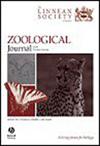古北区新膜蚤属(neskrjabinolepis Spassky, 1947)绦虫的分子系统发育、形态多样性和种类分布
IF 2.8
2区 生物学
Q1 ZOOLOGY
引用次数: 0
摘要
本文研究了广泛分布于古北地区的寄生于鼩鼱身上的新鼩鼱属(neskrjabinolepis)的形态和遗传多样性。提出了一组形态学特征。由于Neoskrjabinolepis schaldybini的模式材料已经丢失,因此从模式寄主Sorex araneus和靠近模式地点(俄罗斯阿尔泰共和国)的地区确定了一个新模式。分析了新种的寄主特异性和地理分布。在17种Neoskrjabinolepis中,有4种寄生在古北的欧洲部分,16种寄生在亚洲部分,2种寄生在新北极。迄今为止,在16种索雷克斯物种中已记录到新skrjabinolepis cestodes。结果表明,该物种具有高地方性(40%)和广泛性。基于28S rRNA基因和线粒体nad1基因部分序列的系统发育分析显示,新猴属物种具有显著的遗传多样性。28S rRNA基因的种间差异为0.2 ~ 1.7%,nad1基因的种间差异为4.4 ~ 19.4%。分子数据显示了一些可能代表不同物种的遗传谱系。结果表明,沙勒比尼和梅库什伐尼的遗传结构复杂,主要分布在高加索地区,表明这两个物种是复合分类群。本文章由计算机程序翻译,如有差异,请以英文原文为准。
Molecular phylogeny, morphological diversity, and species’ distribution of cestodes of the genus Neoskrjabinolepis Spassky, 1947 (Cestoda: Hymenolepididae) in the Palaearctic
Morphological and genetic diversity of species of the cestode genus Neoskrjabinolepis, which parasitise Sorex shrews and are widespread in the Palaearctic, was studied. A set of morphological characteristics is presented. Because the type material of Neoskrjabinolepis schaldybini has been lost, a neotype from the type host Sorex araneus and from a region close to the type locality (Altai Republic, Russia) was designated. Host specificity and the geographical distribution of Neoskrjabinolepis species were analysed. Of the 17 species of Neoskrjabinolepis, four species parasitise hosts in the European part of the Palaearctic, 16 in the Asian part and two in the Nearctic. Neoskrjabinolepis cestodes in 16 species of Sorex have been recorded to date. High endemism (40%) and euryxeny of Neoskrjabinolepis were observed. Phylogenetic analysis based on partial sequences of the 28S rRNA gene and of the mitochondrial nad1 gene revealed significant genetic diversity of Neoskrjabinolepis species. The level of interspecific divergence was established at 0.2–1.7% for the 28S rRNA gene and 4.4–19.4% for the nad1 gene. The molecular data showed some genetic lineages that may represent separate species. Complicated genetic structure of N. schaldybini and N. merkushevae, primarily in the Caucasus, was demonstrated, suggesting that these species are composite taxa.
求助全文
通过发布文献求助,成功后即可免费获取论文全文。
去求助
来源期刊
CiteScore
6.50
自引率
10.70%
发文量
116
审稿时长
6-12 weeks
期刊介绍:
The Zoological Journal of the Linnean Society publishes papers on systematic and evolutionary zoology and comparative, functional and other studies where relevant to these areas. Studies of extinct as well as living animals are included. Reviews are also published; these may be invited by the Editorial Board, but uninvited reviews may also be considered. The Zoological Journal also has a wide circulation amongst zoologists and although narrowly specialized papers are not excluded, potential authors should bear that readership in mind.

 求助内容:
求助内容: 应助结果提醒方式:
应助结果提醒方式:


